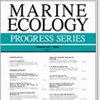巴西东南部一个受保护珊瑚礁生态系统中鱼类和底栖生物群落的空间结构和潜在联系过程
IF 2.2
3区 环境科学与生态学
Q2 ECOLOGY
引用次数: 0
摘要
摘要:自上而下和自下而上的过程都会对生物群落的结构产生影响。一些研究分别支持这些过程在珊瑚礁系统的浮游区和底栖区的作用,但侧重于整个珊瑚礁过程的研究并不多见。在此,我们对巴西东南部阿尔卡特拉泽斯群岛的 3 个 "礁区 "进行了取样:底栖覆盖的群落生物、独居生物和礁鱼(即浮游生物),以确定造成礁区空间群落结构的群体。动态马赛克结构是各区块群落的最佳定义,在连续两年中,在两个深度层中观察到了不同地点之间的巨大变化,而这两个深度层之间被一条急剧的温跃层分隔开来。底栖群落生物覆盖率的变化主要与马尾藻树冠、藻类草皮和鲤形目藻类(Palythoa caribaeorum)的繁殖程度有关。海胆、腹足类和蜗牛等单生生物的丰度呈现出一致的单调变化。然而,我们观察到,在所有珊瑚礁中,大型无脊椎鱼类往往集中在温跃层以上的较暖水域,而不同觅食习性的小型鱼类则出现在较深和较冷的水域。我们观察到,珊瑚礁景观与独居生物之间存在潜在的密切联系,海胆的丰度与马尾藻的覆盖率之间存在负相关关系,这表明存在自上而下的控制。第二种联系是,由铰接草皮和鲤形马尾藻组成的低洼覆盖层与大型无脊椎鱼类之间存在正相关关系,这表明通过提供有利的觅食地,存在自下而上的控制。本文章由计算机程序翻译,如有差异,请以英文原文为准。
Spatial structure and potential processes linking fish and benthic communities in a protected reef ecosystem in SE Brazil
ABSTRACT: Top-down and bottom-up processes can mediate the structuring of biological communities. Several studies have provided separate support for those processes in pelagic and benthic compartments of reef systems but studies focusing on whole-reef processes are less common. Here, we sampled 3 ‘reef compartments’ in the Alcatrazes Archipelago in Southeastern Brazil: benthic cover of colonial organisms, solitary organisms, and reef fish (i.e. pelagic) to identify the groups responsible for spatial community structure among reefs. A dynamic mosaic structure best defines the assemblages of each compartment, with substantial changes observed among sites over 2 consecutive years and at 2 depth strata, separated by a sharp thermocline. Changes in benthic cover of colonial organisms are largely due to the extent of the blooming of Sargassum canopies, algal turfs, and the zoanthid Palythoa caribaeorum. Solitary organisms show a consistent monotonic change in the abundance of sea urchins, ascidians, and snails. Fish assemblage structure differed among reefs; however, we observed that large invertivore fish tended to concentrate in warmer water above the thermocline and small fish of different feeding habits were found in deeper and colder water in all reefs. We observed a potential strong link between the reefscape and solitary organisms, with a negative relationship between the abundance of urchins and the cover of Sargassum spp. suggesting top-down control. A second link is indicated by a positive relationship between low-lying cover composed of articulated turf and P. caribaeorum and larger invertivorous fish, suggesting bottom-up control through the provision of favorable foraging grounds.
求助全文
通过发布文献求助,成功后即可免费获取论文全文。
去求助
来源期刊

Marine Ecology Progress Series
环境科学-海洋学
CiteScore
5.30
自引率
8.00%
发文量
238
审稿时长
3 months
期刊介绍:
The leading journal in its field, MEPS covers all aspects of marine ecology, fundamental and applied. Topics covered include microbiology, botany, zoology, ecosystem research, biological oceanography, ecological aspects of fisheries and aquaculture, pollution, environmental protection, conservation, and resource management.
 求助内容:
求助内容: 应助结果提醒方式:
应助结果提醒方式:


